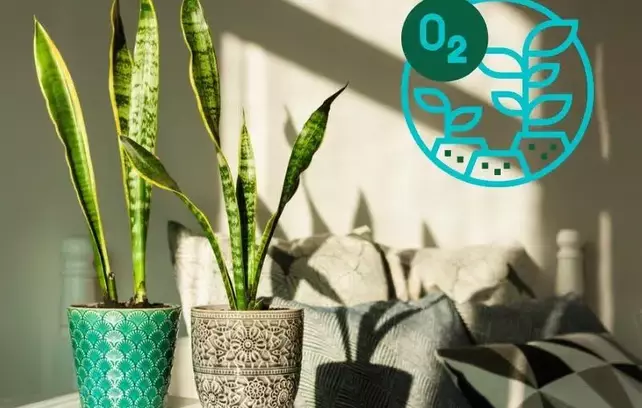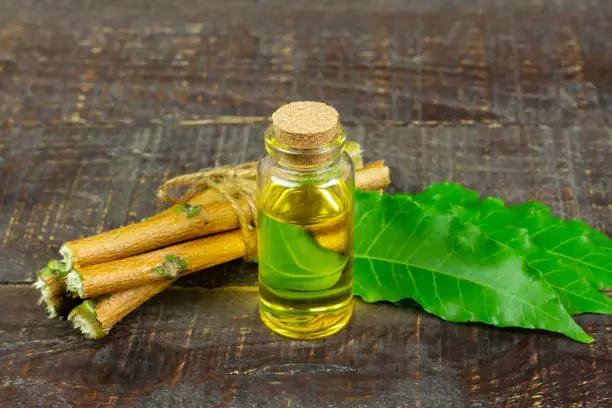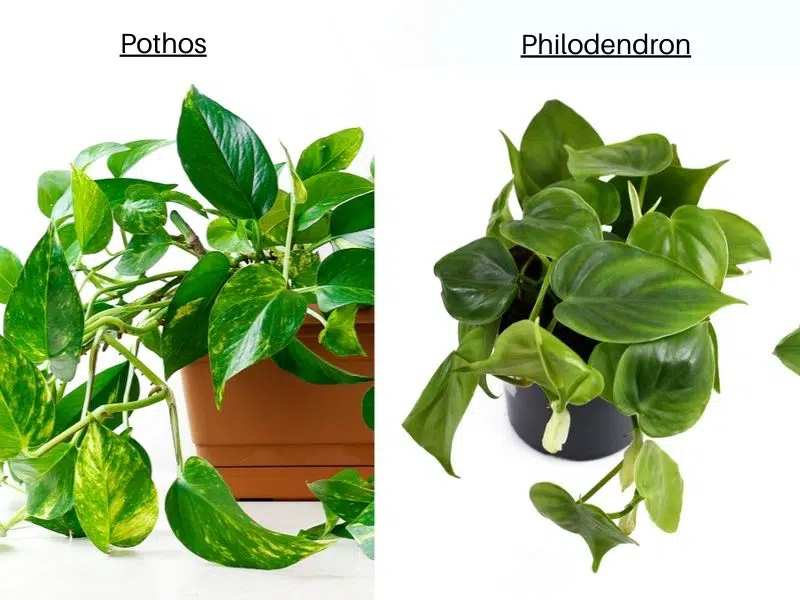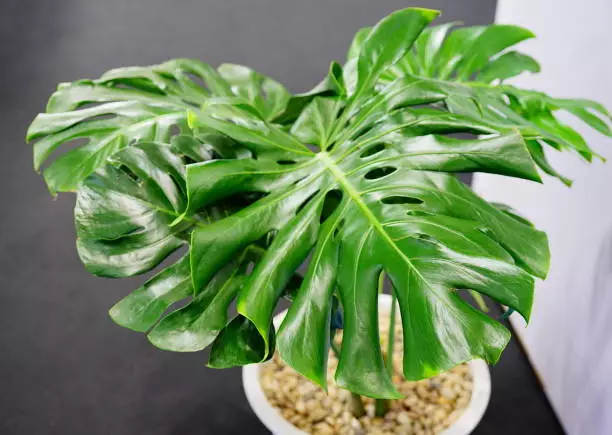With enough space in your house, you might consider some indoor trees or tall, tree-like plants to create a peaceful space for yourself. The problem is that not all spaces are well-lit, so you are limited to indoor trees that can grow in low light. So, what are these trees that don’t need much light?
Indoor trees that grow in low light conditions include the Madagascar dragon tree, umbrella tree, money tree, the Norfolk Island pine, lady palm tree, and rubber plant. You can also grow a corn plant, dumb cane, and areca palms in indoor spaces with very little light away from windows.
Best indoor trees for low light
Low light conditions refer to where the intensity of light is between 25 and 100-foot candles. These plants can thrive in such dim light, but it is preferable to provide medium lighting of up to 500-foot candles for the trees to grow better.
Here’s a list of the best tall and large indoor trees for low light:
1. Rubber plant (Ficus elastic)
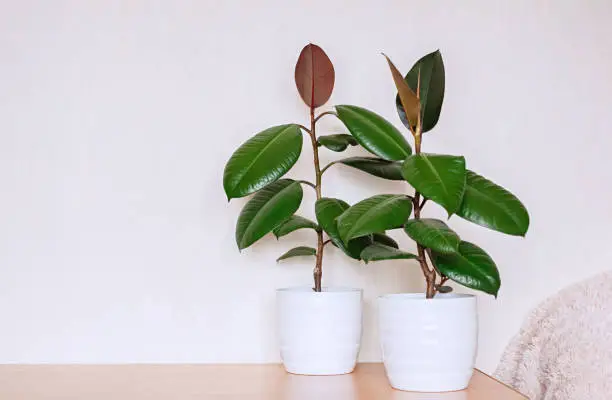
For large indoor trees for low-light rooms, a rubber tree is a great choice because of its large glossy leaves that capture the little light available for photosynthesis. This tree can grow 6 to 10 feet tall when indoors but if this height is too much, you can prune the tree to your desired height.
Although rubber trees do well in bright light, they can adapt to the low light that’s indoors and thrive to become tall trees. You can place your potted rubber tree near the east-facing window in your house where it can enjoy the morning sunlight. Placing it farther away from the window where light intensity decreases are also fine.
RELATED: PLANTS THAT ARE BEST IN EAST-FACING WINDOW
| Name(s) | Ficus elastica, rubber fig, rubber tree, rubber plant. |
| Light requirements | Indirect light – a place near a window indoors. Dim light is also enough. |
| Water requirements | Keep the soil moist but not soggy. Wipe leaves in summer with a damp cloth. |
| Maximum height | 6-10 feet tall (indoors) |
| Indoor benefit | Cleans air to remove toxins e.g. formaldehyde. |
A rubber tree is easy to maintain and grow indoors when you keep its potting soil moist. This can take watering just once or twice a month, especially during the dormant season.
You may need to mist the plant’s leaves or even wipe them with a damp piece of cloth to keep the plant happy and clean indoor air, removing carbon dioxide and breaking it into clean, breathable oxygen.
2. Madagascar dragon tree
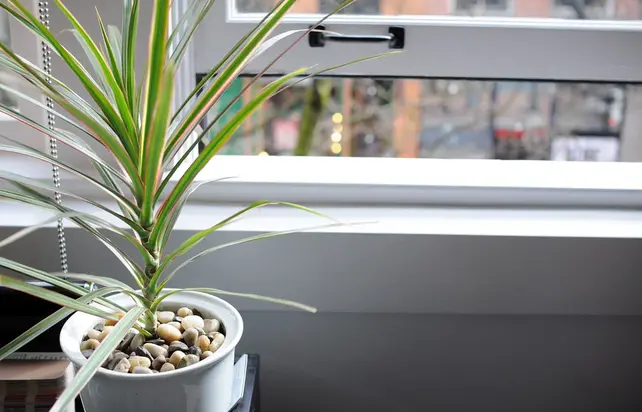
The Madagascar dragon tree (Dracaena marginata) grows well in medium indirect light to low light conditions indoors. As an indoor plant for low light, this tree can grow up to 20 feet tall and may need pruning to retain a height of about 6 feet that’s suitable for most limited or small indoor spaces.
Here’s a fact and care sheet for the indoor Madagascar dragon tree:
| Name(s) | Malaysian Dracaena; Straight-marginated Dracaena; Pleomele Red-marginated Dracaena; Song of India |
| Light requirements | Medium indirect to low light conditions. |
| Water requirements | Water when the soil dries out. |
| Maximum height | Up to 20 feet tall (indoors) |
Dragon trees are hardy in nature and their care routine is not very demanding. Although they grow a little slower than some of the fast-growing houseplants, these trees add texture and color to any home with their bi-color or tricolor foliage depending on the variety.
Generally, they have edged leaves that are reddish or purple in color. The grassy foliage (narrow leaves) gives it a distinct look compared to most indoor low-light plants on this list.
3. Umbrella tree (Schefflera actinophylla)
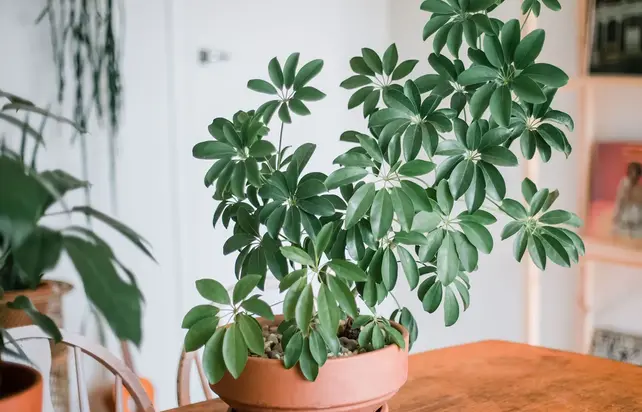
The umbrella tree reaches up to 4-6 feet tall when grown indoors, which makes it a great choice if you want a fairly tall tree for low light conditions. It prefers bright indirect light but can tolerate low light conditions when placed farther away from the window.
I’ve found that the umbrella tree keeps growing while leaning toward the source of light, so you want to rotate the pot often to make it grow full and even.
The umbrella tree requires 3-4 hours of light but the bright, direct sun will burn the plant. I’d recommend that you position it near a southern, western, or eastern-facing window. Make sure it receives filtered light, which means placing it slightly far away from the window or filtering the light with sheer is ideal.
Some varieties of umbrella trees you can choose from include: Trinette, Green gold, Gold Capella, Dazzle, and Compacta.
4. Lady palm (Rhapis excelsa)
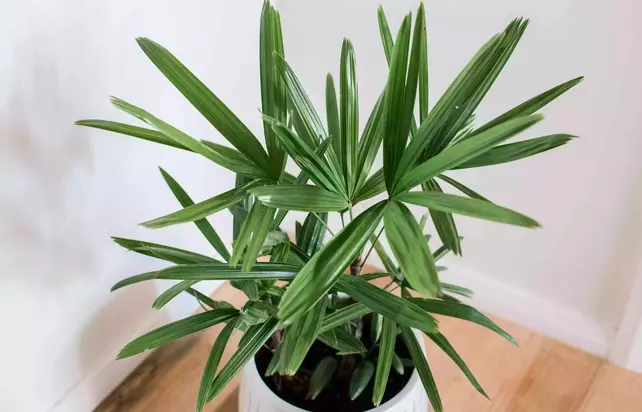
Lady palms are often grown in shady landscapes, but they’re great indoor palm trees for low light conditions. The plant has a clustering growth pattern and can tolerate not only low intensities of light but also the harsh cold during the winter months.
Lady palms require indirect light and can still grow well in very low light and reach a height of 7 feet. Being an evergreen type indoor palm tree, I recommend you place it near doors or areas that are far away from windows because the tree can tolerate low humidity, cold winters, and deep shade.
Without proper care, the green fronds of the palm tree will develop brown tips and appear as though they’re drying up.
Here are growing requirements for lady palms:
- Names: Fan Tufted Palm; Broadleaf Lady Palm; Bamboo Palm
- Light requirements: medium indirect to low light
- Size indoors: 7 feet
- Growth rate: slow
- Water requirements: Low to moderate.
Pro tip: Avoid overwatering your palm trees by allowing the soil to dry out between waterings. Also, make sure you pot them in well-draining soil for better drainage. It helps prevent root rot in your palm trees.
5. Money tree (Pachira aquatic)
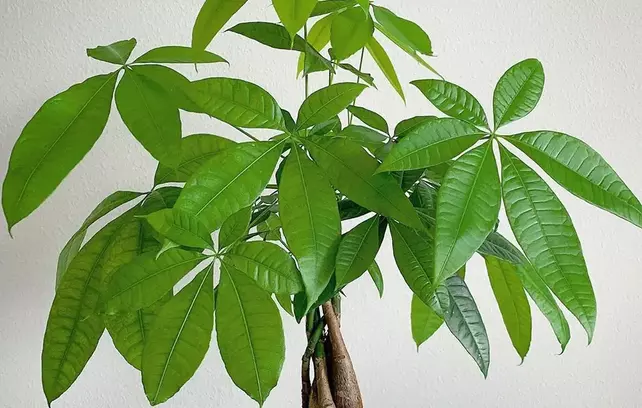
You can grow the money tree in your low-light indoor space as a bonsai houseplant, or let it grow tall. Pachira Aquatica plants can grow to a height of 6-8 feet as tall as houseplants, though in their native wild, they can reach a height of 60 ft.
Grow this tree in a well-draining potting mix and provide water generously but only when the top 1-2 inches of the potting soil is dry to avoid overwatering, which often leads to root rot in money trees.
RELATED: HOW TO SAVE MONEY TREE FROM ROOT ROT
| Name(s) | Guiana Chestnut; Provision tree; French peanut; Malabar chestnut. |
| Light requirements | Bright indirect to low light (tolerance). |
| Water requirements | Once every 1-2 weeks. |
| Maximum height | 6 – 8 feet tall (indoors) |
6. Norfolk island pine (Araucaria heterophylla)
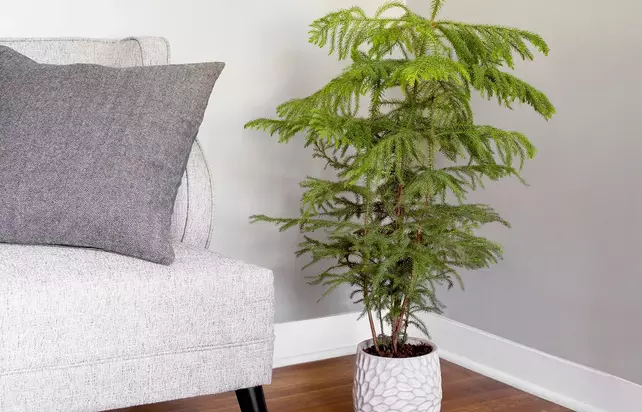
The Norfolk Island pine is a common holiday or Christmas tree that can be grown successfully as a houseplant in spaces that don’t get much light. It is an evergreen plant with many short, narrow needle-like dark green leaves that make it well-adapted to shady conditions that it does not need much sunlight to thrive.
You can place the Norfolk Island Pine near or within 4 feet of a large east, south, or west-facing window where it will receive minimum light for photosynthesis.
It is best if the Norfolk pine receives at least 200-foot candles of light a day to remain healthy and grow its decorative qualities.
7. Corn plant (Dracaena fragrant)
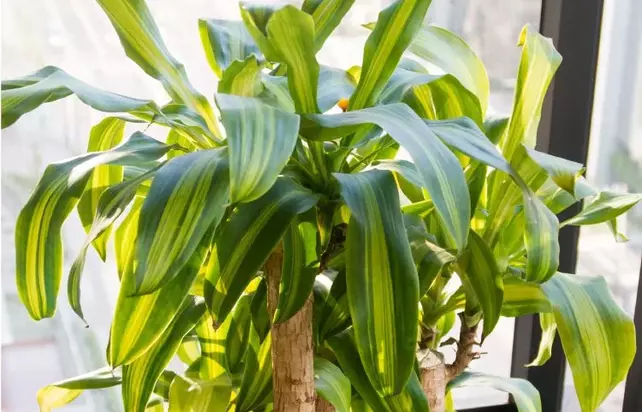
The corn plant is a fairly tall, tree-like indoor plant with a cane-like stalk with rosettes of arching, broad evergreen leaves. It makes for a low-maintenance container indoor plant for low light conditions that can be trained to grow short or on a single stem.
The corn plant prefers shade and will grow well in low light conditions when placed fairly far away from windows.
The name corn plant comes from the fact that the plant has a tall, unbranched stem similar to that of a corn stalk. It grows to a height of up to 6 ft. tall when planted in containers indoors.
Some of the best varieties you can grow indoors as trees for low light include the Dracaena limelight, Dracaena ‘Janet Craig’, and the Lemon Lime Dracaena.
Here are the general requirements for corn plants:
- Names: False palm, Dracaena
- Sun exposure: shade and low light conditions.
- Water requirements: Once every 1-2 weeks.
- Size: 3-10 ft. tall indoors
8. Dumb cane (Dieffenbachia amoena)
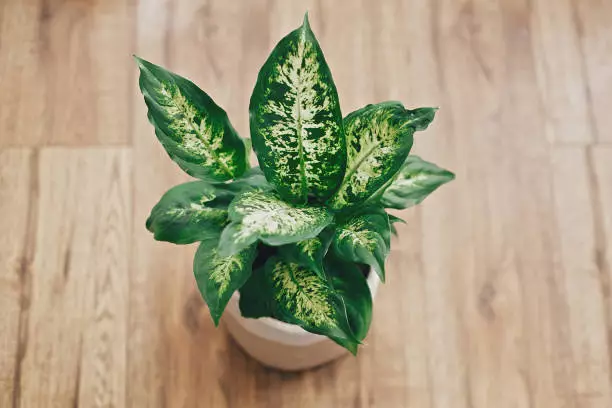
The dumb cane is a tough plant that grows large with astonishing leaves. It can withstand just about any light condition except for direct sunlight that can scorch its leaves. The plant won’t grow in the dark though.
RELATED: WHAT ARE PLANTS THAT GROW IN THE DARK
While it is not technically a tree, the dumb cane grows into a large plant with large variegated leaves bearing white and cream patterns. You can use it as a great option for decorating spaces that can take large trees indoors for beautification.
- Names: Charming Dieffenbachia; Leopard Lily; Tropic Snow; giant dumb cane
- Light needs: Dappled Sunlight to deep shade or no sunlight for long hours.
- Water requirements: Allow the top 1 inch of soil to dry out before watering again.
- Size: 6ft.
While dumb canes don’t need sunlight to thrive, they require at least 2 hours of indirect light for photosynthesis.
Some varieties of dumb cane such as the Tropic Snow can grow to a height of 6 ft. tall indoors.
9. Kentia palm tree (Howea forsteriana)
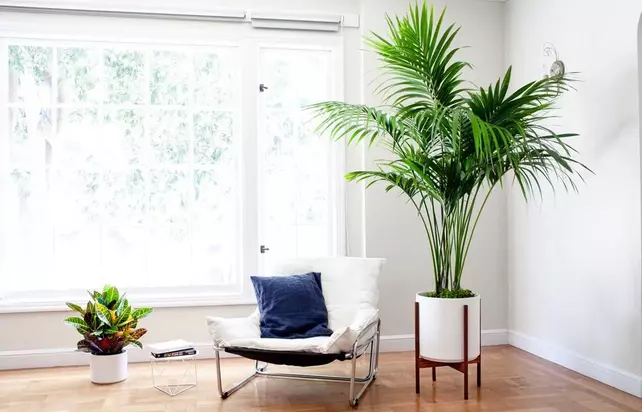
The Kentia palm tree is a common houseplant that can survive quite a bit of negligence and general rough handling. Being a broadleaf evergreen that thrives in harsh conditions, it is one of the best indoor trees for low light conditions.
The Kentia palm prefers indirect sunlight but can tolerate very low light conditions. Never place it where it receives direct sunlight to avoid scorching and general ill-health.
It can also grow up to 12 ft. tall and 4 ft. wide indoors. This large tree may not be very suitable for small apartments due to its size. I’d prefer to grow it in houses that have plenty of space and large windows.
- Names: curly palm, Belmore sentry palm; Howea belmoreana
- Light conditions: indirect low light
- Height: 12 ft. Indoors
Can you grow tall indoor trees in low light?
You can grow tall trees indoors where they may not receive direct sun. However, these plants will still need to receive some indirect light to photosynthesize. Low-light indoor trees can tolerate a light intensity of at least 25-100 foot candles.
However, these trees still need a little more light to thrive and grow healthy. I would recommend that you provide indirect light in the range of 100-500 foot candles, which is categorized as a medium bright light for the plants to remain happy and healthy.
Here’s a list of tall indoor trees that can tolerate low light:
- Rubber plant (10 ft. tall indoors)
- Madagascar dragon tree (20 ft. tall indoors)
- Norfolk Island Pine (8 ft. tall indoors)
- Kentia palm tree (12 ft. tall indoors)
- Corn plant (10 ft. tall indoors)
Light conditions are important but make sure the height of the tree can be accommodated by the space in your house.
Other houseplants that tolerate low light
While some houseplants can thrive and grow in dim conditions, others require a bit more light but can tolerate limited light. However, they may not be able to grow at their optimum.
Here are alternative trees that can tolerate shade and low light situations:
Areca palm
The Areca Palm is one of the best indoor low-light trees due to its low sunlight requirements. If you have a south- or west-facing window, you’ll be able to grow an Areca palm as a large indoor tree that won’t need much sunlight to thrive and enjoy its air cleaning capabilities.
The good thing is that the Areca Palm tree is one of the many types of palm trees that are easy to care for and maintain even when potted. With a simple watering schedule (every 2-3 days), this tree will thrive indoors, especially when placed near a window.
| Name(s) | Chrysalidocarpus lutescens, Dypsis lutescens, golden cane palm, yellow palm, butterfly palm. |
| Light requirements | Bright indirect sunlight (a place near an east, west, or south-facing window). Blinds can help block direct sunlight. |
| Water requirements | Water once every 3 days. Keep the soil slightly moist. |
| Maximum height | 6 to 7 feet tall when growing indoors. |
| Indoor benefit | Air cleaning and removing pollutants. |
Pro tip: If you provide too much direct sunlight, the leaves of this palm tree will easily start discoloring – usually turning yellow. Also, provide just enough water as too much will suffocate the roots and cause root rot.
As is the case with many trees that are native to the tropics, you need to make sure that the palm tree receives moderate temperatures, good air circulation, and is placed in a humid environment.
Citrus
Citrus trees are great fruit trees that you can grow indoors for the benefit of the fruit itself and also beautification. The scent of a lemon or orange tree that is in full bloom is great, so growing these trees in low light conditions is a great idea. You might need a LED to grow light though to maintain healthy trees.
Citrus trees need a lot of water, citrus fertilizer, and humidity. If thinking about having a citrus tree in your house, you should consider purchasing a humidity tray. Take the tray outside whenever possible to ensure that the tree is getting everything it needs to continue growing.
Fiddle leaf fig
You can place fiddle leaf figs in bathrooms or bedrooms that receive fairly medium to low sunlight. While it is not ideal, the tree will survive indoors in such conditions provided other requirements are met, especially watering.
Parlor palm tree
| Name(s) | Chamaedorea elegans, near the Bella palm, parlor palm tree. |
| Light requirements | Low light, mostly indirect sunlight. |
| Water requirements | Water sparingly, 1-2 times a week. Waterless in winter. Always allow the soil to dry before watering again. |
| Maximum height | About 4 feet tall. Desktop parlor trees are shorter (1ft). |
| Indoor benefit | Air purification plant for removing pollutants. |
A parlor palm is a great tree to grow indoors in rooms with low lighting conditions. It is a slow-growing tree that’s native to Mexico and can grow up to four feet tall. With small spaces indoors, it is a good option to grow where it can receive some bright, indirect sunlight.
Apart from being one of the best trees that don’t need much light, parlor palms are easy to grow and maintain indoors because they will easily adjust to shaded conditions and thrive well with minimal attention. As the sun moves away from the windowsill, this tree will still thrive just fine.
Parlor palm trees grow up to 4 feet tall with bamboo-like stems that stand out to make great decorations for your indoor space. 4 feet is fairly tall, so if you want large indoor trees that can tolerate low light, parlor palms will be a great choice.
What about the water requirements of parlor palm trees? The only time you need to water this tree is when you feel that its soil has become dry to your touch. Do not overwater palm trees because they are highly prone to root rot disease. I would recommend that you mist it a little bit during the summer and winter seasons.
Banana tree
Banana trees can grow too tall and large for an indoor set-up but the dwarf varieties are the best for indoor potting and can act as great indoor low-light trees. Plenty of sunlight is ideal but when placed near a window, the low light is enough to keep an indoor banana tree thriving just fine.
| Name(s) | Dwarf banana tree |
| Light requirements | 4-6 hours of full sunlight per day. Supplement with a grow light. |
| Water requirements | Keep the soil moist but not wet. Allow soil to dry before watering again. |
| Maximum height | 5 to 9 feet for indoor dwarf banana trees |
| Indoor benefit | Removes toxins (formaldehyde) in indoor air. |
You want to place this tree near a south-facing window if you want to be successful at growing it indoors for clean air because your banana may need a little more light (4-6 hours of full sunlight) per day.
For the taller varieties, you might want to prune some of the large lower leaves to reduce the amount of space consumed indoors.
When you are out shopping for a good banana tree, you should only consider the dwarf cultivars. The term dwarf is quite relative when it comes to bananas as they can still grow up to ten feet tall.
To enable them to reach their potential, they will need regular fertilizing and filtered light. If you notice that its leaves have started to turn brown or are curling, check whether they have any mites.
What are low-light plants?
Low light plants are plants that can thrive and tolerate light at low intensities, usually about 25-100 foot candles (FC). However, other aspects such as the duration of the light and its quality can also determine how low the natural light is in your home.
Low light plants are plants that can thrive in conditions that have very low lighting. In general, north-facing windows are considered to have low lighting conditions, but, placing plants farther away from the window decreases the intensity of light they’re exposed to. That’s why you need indoor low-light trees and plants for such spaces.
Some plants you can place in low light north-facing windows include the ZZ plant, Resurrection plant, Snake plant, and the Cast iron plant.
These plants tend to be very easy to grow, as many of them require little or no maintenance at all. If you are still not convinced, you need to consider the kind of lighting that is available in your house. For instance, a room that is facing southwards and has many windows will normally have lots of light.
Rooms facing the north or a room that does not have a window are deemed to have very little light or are low-light rooms. For a room that does not have any windows, it is recommended that lights be left on for at least twelve hours each day.
Alternatively, consider rotating your plants for the next few weeks, making sure that you move them from the low-light room into a well-lit room after every few days.
RELATED: HOW TO TAKE CARE OF YOUR ZZ PLANT
What to consider when choosing an indoor plant
Have you ever come across a house plant and wondered what that plant would look like if it was in your conservatory or living room? Then after purchasing it and taking it home you realize that it has become sick and has started posing problems for you.
This is a normal occurrence when a person purchases a plant based on how it looks without taking time to determine whether it is right for the intended room and whether you are in a position to provide it with the care it needs. There are a few considerations to make before buying an indoor plant.
Look at the room conditions
Many people tend to forget vital points, it, therefore, makes sense to take some notes before you can choose a plant.
- Lighting—many indoor plants require bright light without being subjected to direct sunlight rays. If the room where you intend to place the plant is facing east, west, or southwards, then you could be in luck. But if the room happens to be facing the northern part and you intend to grow cacti, then you may have a problem on your hands.
- Temperature—the prevailing temperatures during the summer and spring months tend to be ideal for growing indoor plants. However, you can expect to experience some problems during the cold winter months when the temperatures start to fluctuate as you alternate between switching your central heating system on and off. The problem is further compounded by dropping temperatures and cold drafts that are common during this period. If you are lucky, your plants will survive but many species do not fare so well and eventually end up dying. Therefore, be sure to make inquiries on how a plant reacts to cold weather before you can take it home.
Low light or easy plants
Indoor house plants come in very many forms, with some being easy to grow and maintain. A majority of them, such as the ones discussed above can withstand low lighting conditions without any problems. The buying process can be simplified by choosing any plant that can withstand low lighting conditions. But you need to be careful to make sure that a plant with such needs is not placed on a window facing southwards.
If you happen to have a low-light plant, you will find that many prefer to be neglected than to be given too much of something, e.g., light or water. For many families, these would be the best plants as they will not pose a problem. All you need to do is ensure that you do not overdo anything or else it could harm your plant.
Pets
Another consideration you need to make will involve your pets. Many pets, especially homes with pets can pose a problem for certain indoor house plants. Cats have been known to chew on plants. Given that there are mildly toxic plants, they can make your cats fall sick.
Unlike having a dog, the issue with cats is that they can jump to high places in a bid to get to a plant that has been placed on a top shelf. It is, therefore, worth confirming that the plant is not toxic before you take it home.
Tips to buy indoor house plants
- Cacti and succulents—are an ideal choice for houses that are busy and are likely to forget to water the plant as they are not always at home. Succulent plants and cacti can go for long durations of time without water as their leaves tend to be very strong water storage organs. Additionally, these plants are very resilient.
- Children—if you have small toddlers who are always running around your house, you may want to consider where you place your indoor house plants. Consider the toxicity of your chosen plants to their skin. Some can irritate you if they come into contact with your child’s skin.
- Costs—in many cases, you will find that the cost of a plant will be determined by its size. The larger a plant is, the more expensive it is likely to be. Some of the most expensive plants that you can find in the market are tall—tree-like plants.
Benefits of growing an indoor house plant
It is possible to underestimate the benefits that one can gain by growing an indoor house plant. The benefits outweigh the effort that is applied by the growers as they tend to these plants.
Décor
One of the leading reasons why people have indoor house plants is to improve their décor. It is easy to transform how a room looks and feels by including some indoor house plants.
For instance, you can use palms and shrubs to liven up large rooms and empty spaces. Many plants falling into these two categories can withstand low light conditions and this means that they can be placed in areas such as close to fireplaces, hallways, stairs, and doorways.
The problem for decor growers
Décor growers will find that it is easy for them to purchase the wrong plant for a room. When a room has all the wrong conditions, it is likely to die within no time, and this means that it will not be able to spruce the room as initially intended.
The solution here is to take your time and research the kind of conditions that each plant requires. Focus on temperature and lighting conditions. Fortunately for you, many indoor house plants are easy to maintain and can survive with little or no attention at all. You just have to pick a plant based on the needs of your residents.
Indoor air quality
One major benefit of having an indoor air plant is that the plant can assist you to improve the quality of your indoor air. Such a plant can purify the air and get rid of any toxins that could be present in your environment. You may remember learning about plants that can convert carbon dioxide to oxygen in your science class. These are the plants that you need to have in your home if you want to promote good health for the entire family.
NASA created a study that sought to establish which plants were good for their space stations, and which ones were not. In their study, they listed all the plants that were beneficial to have at home and the kind of pollutants that each plant was capable of eliminating from the environment.
Health and well-being
As mentioned above, removing toxins from the environment is not the only benefit that you can enjoy from having an indoor house plant. Various studies have shown that sick people are likely to get better much faster when they have quality indoor house plants in their rooms.
Additionally, the blooming of flowers has also been known to assist in improving a person’s mood.
References:
[1] North Carolina University Extension: Heptapleurum arboricola
[2] IFAS Extension: Lady palm for low light indoors
[3] University of Maryland Extension: Lighting for Indoor Plants
[4] Wikipedia: NASA Clean Air Study
[5] University of Missouri: Lighting Indoor Houseplants
